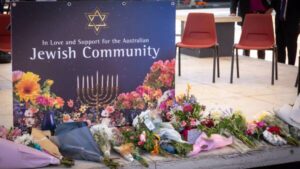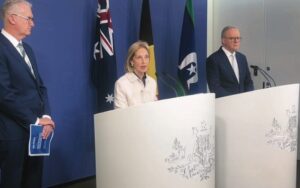
More than 100,000 protesters marched across the Sydney Harbour Bridge on October 7, 2023, demanding an end to the ongoing conflict in Gaza. Despite opposition from the New South Wales government and police, who sought to prevent the demonstration, the event proceeded peacefully, highlighting the complexities surrounding the right to protest in Australia.
The protest, organized by a pro-Palestinian group, encountered significant resistance shortly after its proposal. Peter McKenna, Acting Deputy Commissioner of the New South Wales Police, expressed concerns regarding public safety and potential disruption to traffic. “We understand there is some angst at the moment about what’s happening overseas… but the New South Wales Police decision around this has to be first and foremost about public and police safety,” he stated.
New South Wales Premier Chris Minns echoed these sentiments, indicating that he could not allow Sydney to descend into chaos. He emphasized the logistical challenges associated with closing the Harbour Bridge, noting that such actions occur only a few times in a decade.
While the government’s concerns were valid, Sarah Moulds, an associate professor in law at the University of South Australia, pointed out that Australia has a common law right to communicate about political matters. The right to peaceful assembly is also recognized at the international level, making it essential to balance safety with democratic principles.
As the protest date approached, organizers predicted an attendance of around 50,000 individuals. However, the turnout far exceeded expectations, prompting a legal battle over the right to assemble. The matter was brought before Justice Belinda Rigg of the New South Wales Supreme Court, who ruled in favor of the protesters, citing their right to peaceful assembly.
In her decision, Justice Rigg noted that the urgency of the situation in Gaza warranted a response from the public. She stated, “The horror and urgency of the situation in Gaza demands an urgent and extraordinary response from the people of the world.” Her ruling underscored that inconvenience or disruption alone did not justify prohibiting the protest.
The court’s judgment allowed the protest to proceed, granting participants immunity from charges related to unlawful assembly, provided they adhered to the agreed-upon parameters of the gathering. However, this immunity was limited; participants could still face charges for violent behavior or failing to comply with police orders.
Despite inclement weather, the protest became a historic moment for Sydney, with estimates of over 100,000 individuals participating. Adam Johnson, Acting Assistant Commissioner of the New South Wales Police, described the atmosphere as intense, noting that he had never experienced such a precarious situation in his 35 years of service. Fortunately, the event concluded without violence or injuries, illustrating the effectiveness of organized planning.
Moulds emphasized the importance of maintaining the right to protest in Australia, despite increasing obstacles. She highlighted that current laws differ significantly across states, complicating the landscape for protest organizers. For instance, laws exist in some states that penalize disruptive actions in public spaces, creating confusion among citizens wishing to exercise their democratic rights.
As the government contemplates the implications of the court ruling, Premier Minns stated he would examine whether it sets a legal precedent for future protests. He acknowledged the need for careful consideration to ensure that any changes made to protest regulations do not infringe upon the implied constitutional freedom of political communication.
While the immediate impacts of the protest on international relations may be limited, Moulds believes it empowers citizens to express their views, potentially influencing political leaders. “This action empowers and emboldens our political leaders to engage in international forums and advocate for human rights,” she stated.
The successful organization of such a large-scale protest without major incidents reflects a robust democratic process in Australia. It underscores the importance of balancing public safety with the fundamental right to assemble and communicate political viewpoints, a principle crucial to the health of any democracy.







